Some Quick Gaming Numbers at 4K, Max Settings
by Ian Cutress on July 1, 2013 8:00 AM ESTPart of my extra-curricular testing post Computex this year put me in the hands of a Sharp 4K30 monitor for three days and with a variety of AMD and NVIDIA GPUs on an overclocked Haswell system. With my test-bed SSD at hand and limited time, I was able to test my normal motherboard gaming benchmark suite at this crazy resolution (3840x2160) for several GPU combinations. Many thanks to GIGABYTE for this brief but eye-opening opportunity.
The test setup is as follows:
Intel Core i7-4770K @ 4.2 GHz, High Performance Mode
Corsair Vengeance Pro 2x8GB DDR3-2800 11-14-14
GIGABYTE Z87X-OC Force (PLX 8747 enabled)
2x GIGABYTE 1200W PSU
Windows 7 64-bit SP1
Drivers: GeForce 320.18 WHQL / Catalyst 13.6 Beta
GPUs:
| NVIDIA | ||||||
|---|---|---|---|---|---|---|
| GPU | Model | Cores / SPs | MHz | Memory Size | MHz | Memory Bus |
| GTX Titan | GV-NTITAN-6GD-B | 2688 | 837 | 6 GB | 1500 | 384-bit |
| GTX 690 | GV-N690D5-4GD-B | 2x1536 | 915 | 2 x 2GB | 1500 | 2x256-bit |
| GTX 680 | GV-N680D5-2GD-B | 1536 | 1006 | 2 GB | 1500 | 256-bit |
| GTX 660 Ti | GV-N66TOC-2GD | 1344 | 1032 | 2 GB | 1500 | 192-bit |
| AMD | ||||||
| GPU | Model | Cores / SPs | MHz | Memory Size | MHz | Memory Bus |
| HD 7990 | GV-R799D5-6GD-B | 2x2048 | 950 | 2 x 3GB | 1500 | 2x384-bit |
| HD 7950 | GV-R795WF3-3GD | 1792 | 900 | 3GB | 1250 | 384-bit |
| HD 7790 | GV-R779OC-2GD | 896 | 1075 | 2GB | 1500 | 128-bit |
For some of these GPUs we had several of the same model at hand to test. As a result, we tested from one GTX Titan to four, 1x GTX 690, 1x and 2x GTX 680, 1x 660Ti, 1x 7990, 1x and 3x 7950, and 1x 7790. There were several more groups of GPUs available, but alas we did not have time. Also for the time being we are not doing any GPU analysis on many multi-AMD setups, which we know can have issues – as I have not got to grips with FCAT personally I thought it would be more beneficial to run numbers over learning new testing procedures.
Games:
As I only had my motherboard gaming tests available and little time to download fresh ones (you would be surprised at how slow in general Taiwan internet can be, especially during working hours), we have a standard array of Metro 2033, Dirt 3 and Sleeping Dogs. Each one was run at 3840x2160 and maximum settings in our standard Gaming CPU procedures (maximum settings as the benchmark GUI allows).
Metro 2033, Max Settings, 3840x2160:
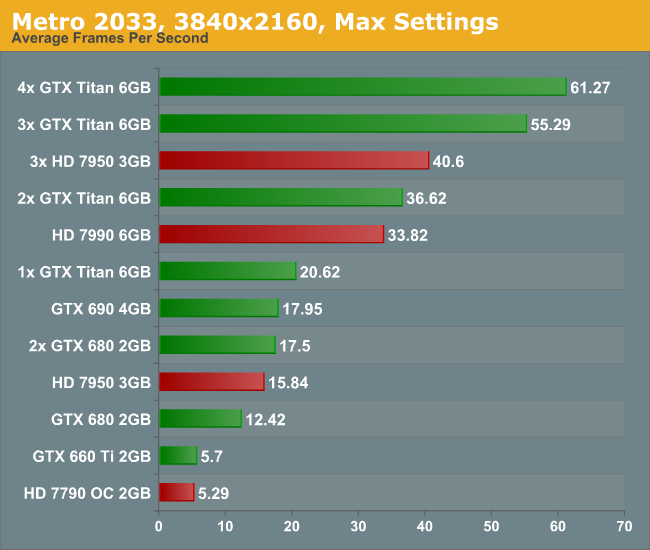
Straight off the bat is a bit of a shocker – to get 60 FPS we need FOUR Titans. Three 7950s performed at 40 FPS, though there was plenty of microstutter visible during the run. For both the low end cards, the 7790 and 660 Ti, the full quality textures did not seem to load properly.
Dirt 3, Max Settings, 3840x2160:
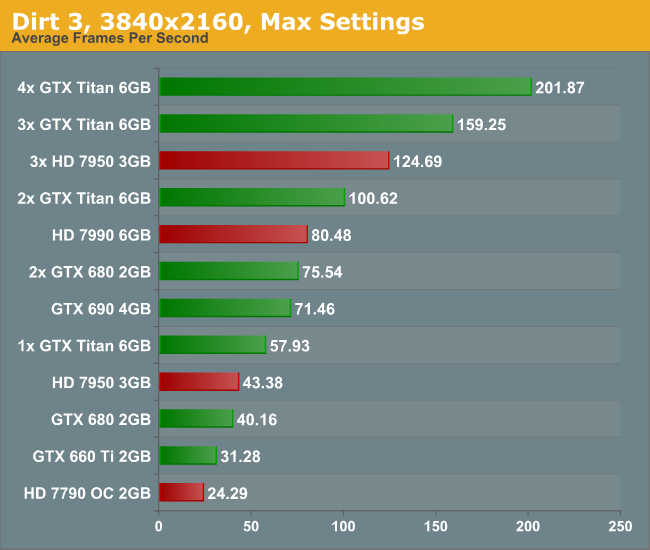
Dirt is a title that loves MHz and GPU power, and due to the engine is quite happy to run around 60 FPS on a single Titan. Understandably this means that for almost every other card you need at least two GPUs to hit this number, more so if you have the opportunity to run 4K in 3D.
Sleeping Dogs, Max Settings, 3840x2160:
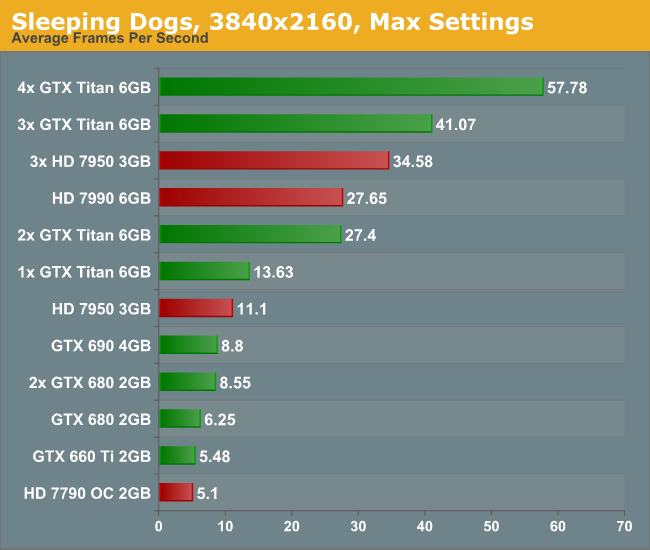
Similarly to Metro, Sleeping Dogs (with full SSAA) can bring graphics cards down to their knees. Interestingly during the benchmark some of the scenes that ran well were counterbalanced by the indoor manor scene which could run slower than 2 FPS on the more mid-range cards. In order to feel a full 60 FPS average with max SSAA, we are looking at a quad-SLI setup with GTX Titans.
Conclusion:
First of all, the minute you experience 4K with appropriate content it is worth a long double take. With a native 4K screen and a decent frame rate, it looks stunning. Although you have to sit further back to take it all in, it is fun to get up close and see just how good the image can be. The only downside with my testing (apart from some of the low frame rates) is when the realisation that you are at 30 Hz kicks in. The visual tearing of Dirt3 during high speed parts was hard to miss.
But the newer the game, and the more elaborate you wish to be with the advanced settings, then 4K is going to require horsepower and plenty of it. Once 4K monitors hit a nice price point for 60 Hz panels (sub $1500), the gamers that like to splash out on their graphics cards will start jumping on the 4K screens. I mention 60 Hz because the 30 Hz panel we were able to test on looked fairly poor in the high FPS Dirt3 scenarios, with clear tearing on the ground as the car raced through the scene. Currently users in North America can get the Seiki 50” 4K30 monitor for around $1500, and they recently announced a 39” 4K30 monitor for around $700. ASUS are releasing their 4K60 31.5” monitor later this year for around $3800 which might bring about the start of the resolution revolution, at least for the high-end prosumer space.
All I want to predict at this point is that driving screen resolutions up will have to cause a sharp increase in graphics card performance, as well as multi-card driver compatibility. No matter the resolution, enthusiasts will want to run their games with all the eye candy, even if it takes three or four GTX Titans to get there. For the rest of us right now on our one or two mid-to-high end GPUs, we might have to wait 2-3 years for the prices of the monitors to come down and the power of mid-range GPUs to go up. These are exciting times, and we have not even touched what might happen in multiplayer. The next question is the console placement – gaming at 4K would be severely restrictive when using the equivalent of a single 7850 on a Jaguar core, even if it does have a high memory bandwidth. Roll on Playstation 5 and Xbox Two (Four?), when 4K TVs in the home might actually be a thing by 2023.
16:9 4K Comparison image from Wikipedia


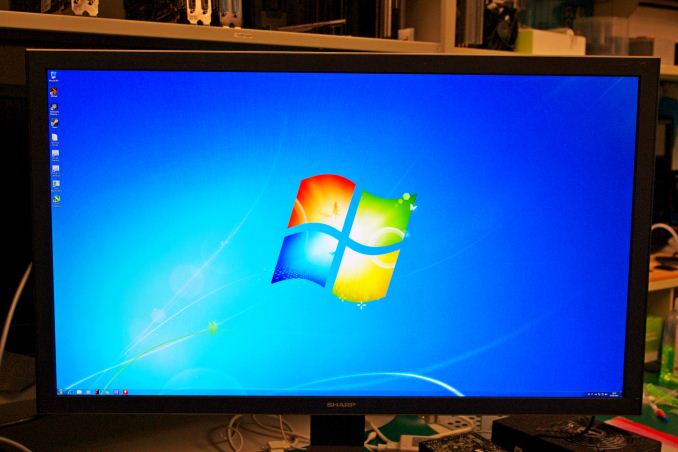

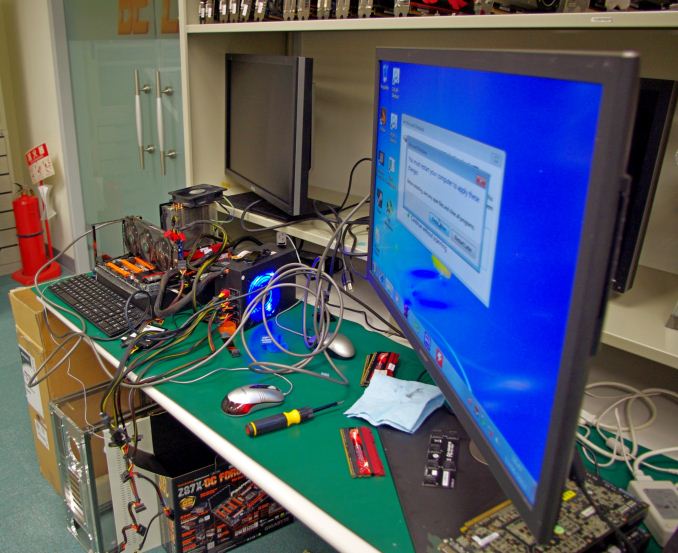

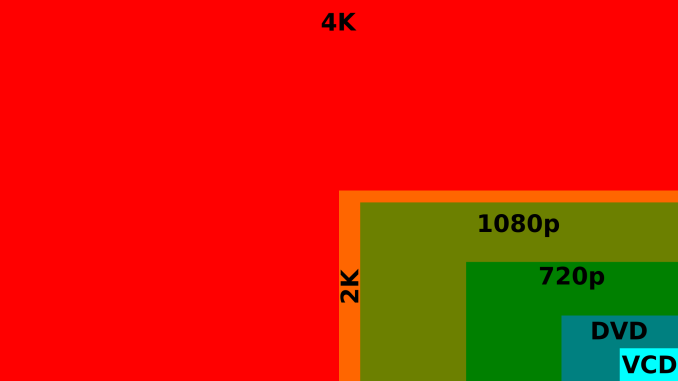








134 Comments
View All Comments
IanCutress - Monday, July 1, 2013 - link
I wish I did as well! Perhaps SSAA was properly overkill at that resolution; with more testing I would obviously like to see the differences. Though it may be a while before I can get a 4K in to test.mavere - Monday, July 1, 2013 - link
Retina iOS games running native with 2x MSAA will still display some jaggies here and there. Maybe 4x MSAA?mapesdhs - Tuesday, July 2, 2013 - link
Ian, there are kindof a few models available in the UK, if you have the moolah. ;)
http://www.thruput.co.uk/products/monitors/56-8-Me...
http://s3dpostproduction.co.uk/mitsubishi-56p-qf60...
As for pricing though, interesting to contrast this:
http://www.tnpbroadcast.co.uk/Product/TVLogic_LUM-...
with this:
http://www.gizmodo.co.uk/2013/04/seiki-50-inch-4k-...
:D
Another headline I found:
http://www.sharp.co.uk/cps/rde/xchg/gb/hs.xsl/-/ht...
Ian.
PS. Alternative: use a splitter to feed the output into 4 separate HD displays? Or would
that mess up the GPU's ability to detect that it's able to drive a 3840x2160 display?
makerofthegames - Monday, July 1, 2013 - link
I game on a 1440p monitor, and antialiasing is still useful at that resolution. It's just not as important as at lower resolutions - on my old 1600x900, anything short of 8x AA seemed jaggy, but at 2560x1440, 2xMSAA is generally fine, maybe 4xMSAA if there's horsepower for it. In some games I actually prefer to use just FXAA, instead putting the horsepower behind some other setting. At 2160p, I would expect 2xMSAA to still be somewhat useful, although more than that is probably overkill (and 8xSSAA is already overkill at 1440p).Of course, overkill is fun sometimes. I actually run some older games (like UT3) with 8xSSAA, just because I can still get 80+ FPS with everything maxed out.
nathanddrews - Monday, July 1, 2013 - link
I was thinking the same thing. At that PPI, don't you essentially get AA for free? Any chance you collected FPS with AA disabled? I would happily suffer through some very minor artifacts to get a smoother 4K experience. Not unlike when I used to play games at 1920x1200 without AA on my old Dell 17" laptop (Core Duo, 7950Go).While I know it's a different scenario than with fixed pixel displays, I currently do that with my FW900. I run it at 2560x1600@75Hz with some games, but I run them without AA and can't detect (most) artifacts.
I know AT wants to push the bleeding edge here and that this is just a quick look, but $700-1200 for a 4K monitor (Seiko) isn't exactly in the same ultra-enthusiast territory as 4X Titans. That said, it would be nice to see some benchmarks at 4K with medium-to-high settings without AA for the less-wealthy enthusiasts.
Also, does this monitor also operate well at 1080p@120fps?
chizow - Monday, July 1, 2013 - link
Yeah 4K is effectively 1080p with 2x2 SSAA, or 4xSSAA. Does seem overkill, but even at higher resolutions, AA can be beneficial to reduce shimmering by reducing pixel transitions in motion.iamezza - Monday, July 1, 2013 - link
+1airmantharp - Tuesday, July 2, 2013 - link
My initial thought was that Ian was trying to set a long-term baseline; using these settings in the future, he'd be able to show how far future cards have come relative to the (future) old beasts.BMNify - Sunday, July 7, 2013 - link
because its there, and it clearly shows that at only 4K these gfx cores Need a lot more work to come up to standard when people migrate to this standard, And note I said "at Only 4K" ....the reasoning is simple, the UK,Japanese and Chinese PBS are all working to implement Real 8K over the air broadcasting technology Today and for several years now with the expected commercial retail availability by 2020 .... so this near 4k/2k standard is only the start of the ultra HD transition and there's not much reative time to get the computer GFX up to speed at and affordable price point to make it a generic mid range option by 2020 never mind 2023
MordeaniisChaos - Sunday, July 7, 2013 - link
Considering this is testing 4K resolutions, it's not really judging "real world" environments. So I think the SSAA and running it with everything pumped up is a good way to go. Especially considering we are on the cusp of games getting much better looking, so in a way it could very well be appropriate. We won't be playing games in 4K for quite some time just because the screens aren't really out there for the every man. By then the games will look much better, much denser, with lots of fancy new rendering techniques.